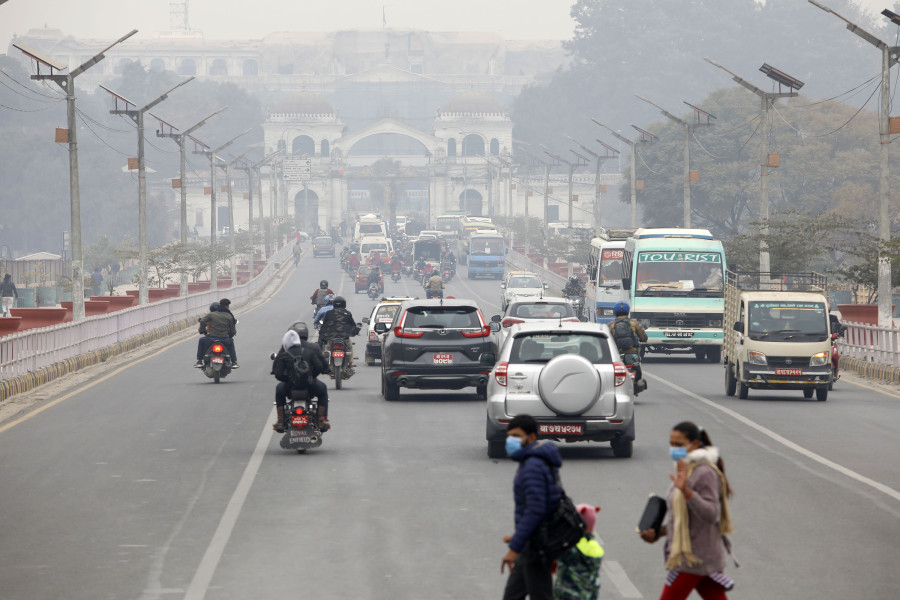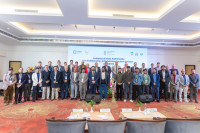National
Government mute as Kathmandu air deteriorates to ‘hazardous’ levels
Air Quality Index crosses the 600 mark, raising public health concerns amid the Covid-19 pandemic.
Chandan Kumar Mandal
Air quality in Kathmandu Valley deteriorated to ‘hazardous levels’ on Monday, crossing the 600 mark, fuelling concerns about respiratory complications especially among the elderly, children and Covid-19 patients.
According to IQ Air, a Swiss group that collects real-time air-quality data from around the world, Kathmandu’s overall air-quality readings hit the roof, making it the most polluted city in the world, followed by New Delhi.
The air quality in the Valley usually remains at ‘unhealthy’ levels during summer while the monsoon brings some respite to valley residents, but the situation quickly worsens in winter when bad air is trapped in the Valley due to the topography and meteorological conditions.
On Monday, the readings quickly went from ‘unhealthy’ to ‘very unhealthy’ and ‘hazardous’ by the end of the day. Overall AQI (Air Quality Index) levels haven’t dropped since Monday night while westerly winds have enveloped the country with dense fog.
Vehicular emission, forest fires and cross-border industrial pollution too have contributed to the deterioration in Kathmandu air quality.
The air-quality monitoring station at Ratna Park recorded particulate matter pollution (PM2.5) levels of 488 micrograms per cubic meter by 5:45pm, which increased to 667 by 9:45 PM.
The station also recorded the highest AQ level of 413 by 8:45 PM with a peak PM2.5 concentration of 368.7 μg/m3 at the same time.
Another station nearby at Phora Durbar crossed AQI level of 300 at 4:15 PM, which soared to 662 by 9:45 PM. Peak PM2.5 concentration stood at a record 746 μg/m3.
On Tuesday afternoon, Kathmandu’s AQI level hovered at 437, keeping the capital on the list of the most polluted cities in the world.
Indu Bikram Joshi, deputy director-general of the Department of Environment, said the ongoing weather condition has further exacerbated the air pollution level in the Valley.
“We normally have poor air during winter seasons. But this only got worse because of the weather,” said Joshi, who is also the spokesperson for the department. “The weather condition works as a blanket and traps the pollutants which could have moved away.”
According to EPA’s air quality index, air quality levels between 151-2oo is considered ‘unhealthy’, and everyone may experience problems, with sensitive groups feeling more severe effects.
Levels exceeding AQI 300 are considered ‘hazardous’ for everyone and may prompt emergency alerts. The public is asked to avoid all outdoor activities, close windows, run air purifiers indoors, and wear filter masks if necessary to venture out.
The existing Kathmandu Valley’s Air Pollution Management Action Plan has a provision that the authorities can declare a public health emergency whenever AQI readings exceed 300.
The Cabinet had endorsed the action plan on February 24 last year.
But the government authorities have not thought of declaring a public health emergency as of now, according to Joshi.
“As winter starts, we start public awareness campaigns to discourage open-burning and other measures to control the pollution level,” said Joshi. “We have not thought about declaring a public health emergency yet as most of the schools and colleges are shut, and brick kilns have remained closed.”
According to Joshi, if the situation worsens further, the authorities might consider a public health emergency.
“But we cannot take any unnecessary actions in a haste when the country is already dealing with the impacts of the Covid-19 pandemic,” said Joshi.



 7.12°C Kathmandu
7.12°C Kathmandu















